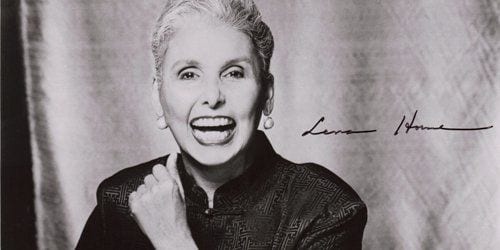
Lena Horne passed away on 9 May 2010 at 92-yearsold. Within minutes of the announcement, “Lena Horne R.I.P. 1917-2010” Tweets and links to YouTube clips multiplied across social networks. Through the collective voice of user-generated media, the legacy of Lena Horne suddenly became more vibrant and multi-dimensional than the standard obituaries that rushed to print in the wake of her passing. Elegant, classy, feisty, heroic, Ms. Horne informed a staggering range of individual, personal narratives. To my set of three year-old eyes, she was that larger than life Lady in the record store — her arms triumphantly outstretched on the cover of The Lady and Her Music (1981), an album that documented Ms. Horne’s Tony and Grammy Award-winning one-woman show.
That iconic cover image symbolized a life that blazed trails long before such a concept even entered the public discourse. I implore you, don’t rely on Wikipedia or a pat obituary to grasp the impact Lena Horne had on stage, screen, civil rights, and social justice. Go to the best authority on the life of Lena Horne — the Lady herself.
Silence and unplug all of your devices and spend two hours with The Lady and Her Music. In her inimitable delivery, Ms. Horne shares moments from her professional life, with poignant and humorous asides interspersed throughout two acts of career-defining songs: “Just One of Those Things”, “The Lady Is a Tramp”, and, of course, “Stormy Weather”. She traces her ascent from Cotton Club dancer to the toast of New York’s nightclubs, from barrier-breaking Hollywood actress (Cabin in the Sky, 1943) to a leading lady on Broadway (Jamaica, 1957). She even challenges the acting chops of Bo Derek, Cheryl Tiegs, Cher and “all them soap opera queens you done ever seen, honey!” in my personal favorite, “I’m Going to Sit Right Down and Write Myself a Letter”, a song she learned from Fats Waller when she was just 17 years old. If you can locate the original, two-album vinyl set, you’ll discover a generous spread of photographs from the personal collection of Ms. Horne, which documents her life far better than Google images. (The photos also appear in the CD edition of the album albeit in smaller, fuzzier versions.)
Ms. Horne punctuates the show with a heart-stopping performance of “If You Believe”, her theme as Glinda the Good Witch from The Wiz (1978). Her vocal pyrotechnics obliterate the ill-informed observation that appeared in The New York Times’ obituary immediately following the announcement of the singer’s passing: “Ms. Horne’s voice was not particularly powerful”. It is exactly because of the arresting power in Ms. Horne’s voice that the generation who grew up with The Wiz on home video found the inspiration to believe. On The Lady and Her Music recording, it is the transcendent power of her delivery that opened up the tear-ducts in the Nederlander Theatre and made believers out of a misty-eyed but invigorated audience. In the privacy of your own home, and on this still-remarkable recording, you will believe too.

![Call for Papers: All Things Reconsidered [MUSIC] May-August 2024](https://www.popmatters.com/wp-content/uploads/2024/04/all-things-reconsidered-call-music-may-2024-720x380.jpg)



